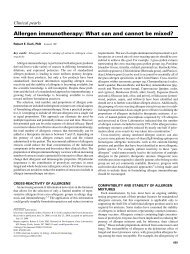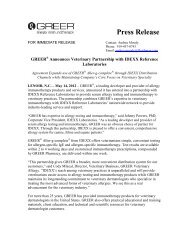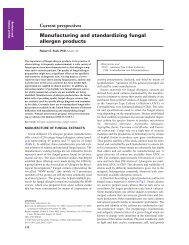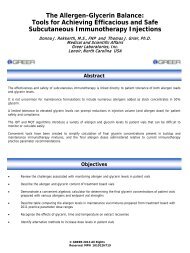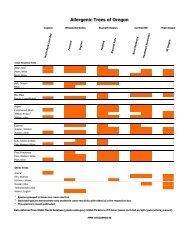Mixing Compatibility of Phenolated, Glycerinated Allergenic ... - Greer
Mixing Compatibility of Phenolated, Glycerinated Allergenic ... - Greer
Mixing Compatibility of Phenolated, Glycerinated Allergenic ... - Greer
You also want an ePaper? Increase the reach of your titles
YUMPU automatically turns print PDFs into web optimized ePapers that Google loves.
<strong>Mixing</strong> <strong>Compatibility</strong> <strong>of</strong> <strong>Phenolated</strong>, <strong>Glycerinated</strong> <strong>Allergenic</strong> ExtractsStored at Refrigeration or Ambient TemperaturesTJ Grier, PhD, DM LeFevre, BS, EA Duncan, BS, KN Whitaker, BS, RE Esch, PhD and TC Coyne, MDResearch & Development Laboratory <strong>Greer</strong> Laboratories, Inc. Lenoir, North Carolina USAOverview and MethodologyAllergen Compatibilities for Mixtures Stored at 2-8 CScope<strong>Glycerinated</strong> allergenic extracts are utilized by allergy clinics with increasing frequencybecause <strong>of</strong> their enhanced physical and biochemical stabilities relative to aqueous products.<strong>Phenolated</strong> extract mixtures containing 50% glycerin are <strong>of</strong>ten employed as stockconcentrates for testing and treatment, or as patient-specific formulations. For manycommon extract mixtures, the stabilities <strong>of</strong> allergens present in these solutions during typicalstorage or daily-use conditions have not been investigated.This handout summarizes the compatibilities <strong>of</strong> various phenolated (0.2%), glycerinated(50%) allergenic extracts determined after mixing with high-protease (fungal, insect) and/orlow-protease (pollen, animal, dust mite) glycerinated products and storage for up to 12months at refrigeration (2-8 C) or ambient (20-25 C) temperatures.Extract activities in mixtures were determined after storage for 1-12 months at 2-8 C. Mean recoveries <strong>of</strong>70% or higher (stable, green shading), 50-69% (risky, yellow shading) and below 50% (unstable, redshading) are illustrated below.Target Mixed w/ Mean % Recovery after mixing and storage for ...Months at 2-8 CMonths at 2-8 C+ 1 3 6 12 + 1 3 6 12Alternaria 94 79 70 36 American cockroach 150 33 54Aspergillus 68 77 63 33 German cockroach 115 50 45Materials and MethodsAllergen mixtures and control samples were prepared using licensed glycerinated (50% v:v)<strong>Greer</strong> extract concentrates and AP dog hair-dander extract obtained from Hollister Stier.Each product was sourced at its highest available glycerinated strength.Two-component extract mixtures and single-component extract controls were formulated atone-tenth <strong>of</strong> concentrate strengths in 2-5 mL total volumes using 50% glycero-normal salinediluent. All samples were analyzed after storage for 1-12 months at 2-8 C or 20-25 C.Test sample potencies were determined by quantitative human IgE ELISA inhibition andradial immunodiffusion assays, the methods established by FDA for extract standardizationin the United States.IgE ELISA inhibition assays were performed to determine the allergenic potencies <strong>of</strong> avariety <strong>of</strong> allergenic extracts. Microtiter plates coated with saturating levels <strong>of</strong> targetallergens were co-incubated with serial dilutions <strong>of</strong> reference (controls) or test allergens(mixtures) and IgE-positive human serum pools reactive with the target allergens. Paralleldose-response curves bracketing 50% inhibition levels were observed for controls andmixtures. Relative IgE-binding potencies were calculated using a parallel line bioassayspreadsheet similar to those employed for lot release and stability testing <strong>of</strong> standardizedgrass pollen and dust mite extracts.Radial immunodiffusion assays for short ragweed allergen Amb a 1 and cat hair allergen Feld 1 employed specific allergen standards, anti-Amb a 1 and anti-Fel d 1 sheep antisera, andincubation conditions identical to those used for standardization <strong>of</strong> short ragweed and cathair extracts.Two-site ELISA analyses for major allergenic proteins in several products were alsoperformed on some mixtures. These assays utilized allergen-specific mouse or rabbit captureand biotinylated probe antibodies, with results obtained by log-linear regression <strong>of</strong> calibratedallergen standards and multiple test sample dilutions.Percent recoveries for extract mixtures were expressed relative to the activities <strong>of</strong> singleextractcontrols containing identical concentrations <strong>of</strong> test allergens. Recoveries weretypically within 10% <strong>of</strong> mean values for replicate samples.Results were assessed for significance by T test (p ≤ 0.05).MPN 102411H445MeadowfescuegrassTimothygrassBermudagrassJohnsongrassCatPenicillium 62 71 50 32 Fire ant invicta 156 63 75Cladosporium 76 136 49 D. farinae 101 89Epicoccum 69 96 D. pteronyssinus 87 103Aureobasidium 72 177 Short ragweed 59 51 61Giant 10 ragweed 25 50Fusarium 152 73 102 63 75Mucor 70 78 False ragweed 68 59 73Bipolaris 94 100 82 49 Western ragweed 69 47 72Desert ragweed 99 95 79+ 1 3 6 12 + 1 3 6 12Alternaria 48 72 58 Short ragweed 100 99 90 86Aspergillus 78 62 45 Giant ragweed 100 104 111 111Penicillium 39 32 21 False ragweed 116 110 88Cladosporium 68 102 104 Western ragweed 73 114 90Bipolaris 66 69 66 Desert ragweed 93 104 111American cockroach 51 53 54 Fire ant invicta 114 70 57German cockroach 48 59 44+ 1 3 6 12 + 1 3 6 12Short ragweed 95 96 96 95 Short ragweed 95 96 96 95+ 1 3 6 12 + 1 3 6 12Short ragweed 106 56 97 86 Giant ragweed 91 53 105 90+ 1 3 6 12 + 1 3 6 12Alternaria 102 100 American cockroach 97 102Aspergillus 98 102 German cockroach 96 94Penicillium 100 102 Short ragweed 105 108 108Giant ragweed 114 110 110
<strong>Mixing</strong> <strong>Compatibility</strong> <strong>of</strong> <strong>Phenolated</strong>, <strong>Glycerinated</strong> <strong>Allergenic</strong> ExtractsStored at Refrigeration or Ambient TemperaturesTJ Grier, PhD, DM LeFevre, BS, EA Duncan, BS, KN Whitaker, BS, RE Esch, PhD and TC Coyne, MDResearch & Development Laboratory <strong>Greer</strong> Laboratories, Inc. Lenoir, North Carolina USAAllergen Compatibilities for Mixtures Stored at 20-25 CTarget Mixed w/ Mean % Recovery after mixing and storage for ...Target Mixed w/ Mean % Recovery after mixing and storage for ...Months at 20-25 CMonths at 20-25 CMonths at 20-25 CMonths at 20-25 C+ 1 3 6 12 + 1 3 6 12+ 1 3 6 12 + 1 3 6 12Alternaria 35 36 13 Short ragweed 70 60 38Alternaria 93 65 78 American cockroach 105 69 80MeadowfescuegrassAspergillus 16 18 5 Giant ragweed 57 57 46Penicillium 21 11 7 False ragweed 60 48 34Cladosporium 54 56 36 Western ragweed 82 50 42Bipolaris 54 23 6 Desert ragweed 98 69 61D.farinae(IgE)Aspergillus 102 93 86 German cockroach 96 86 98Penicillium 105 86 91 Fire ant invicta 102 118 130Cladosporium 108 76 90 Short ragweed 94 158 138+ 1 3 6 12 + 1 3 6 12American cockroach 32 17 7 Fire ant invicta 43 39 12Alternaria 110 111 107 American cockroach 119 91 113German cockroach 28 33 8+ 1 3 6 12 + 1 3 6 12D.farinae(Der f 1)Aspergillus 102 79 108 German cockroach 108 102 118Penicillium 108 74 112 Fire ant invicta 103 104 129Alternaria 47 32 16 6 Short ragweed 92 85 70 84Cladosporium 120 94 11010 25 50Aspergillus 38 20 9 Giant ragweed 91 101 103 175+ 1 3 6 12 + 1 3 6 12Penicillium 14 8 2 False ragweed 97 101 71Alternaria 106 83 95 American cockroach 129 127 97TimothygrassCladosporium 86 77 70 Western ragweed 83 50 83Bipolaris 71 44 22 Desert ragweed 135 100 77Dogepithelia(IgE)Aspergillus 109 76 94 German cockroach 106 94 82Penicillium 112 114 125 Fire ant invicta 107 102 101American cockroach 47 19 9 Fire ant invicta 51 45 9Cladosporium 136 120 120 Short/giant ragweed 105 127 101 185German cockroach 33 18 10+ 1 3 6 12 + 1 3 6 12+ 1 3 6 12 + 1 3 6 12Alternaria 98 85 57 American cockroach 89 103 112BermudagrassShort ragweed 101 180 334 Giant ragweed 120 172 347+ 1 3 6 12 + 1 3 6 12Dogepithelia(Can f 3)Aspergillus 99 82 69 German cockroach 92 106 105Penicillium 81 107 72 Fire ant invicta 95 126 103JohnsongrassShort ragweed 103 76 126 Giant ragweed 97 81 151Cladosporium 107 112 100 Short/giant ragweed 190 245+ 1 3 6 12 + 1 3 6 12+ 1 3 6 12 + 1 3 6 12Alternaria 92 92 67 American cockroach 109 93 108CatAlternaria 100 100 96 American cockroach 104 100 105Aspergillus 91 92 91 German cockroach 96 100 100Penicillium 96 92 91 Fire ant invicta 100 104 100Dogdander(IgE)Aspergillus 84 60 34 German cockroach 79 83 82Penicillium 94 74 62 Fire ant invicta 109 110 88Cladosporium 116 92 113 Short/giant ragweed 101 189 134 232Cladosporium 104 104 105 Short/giant ragweed 105 110 117+ 1 3 6 12 + 1 3 6 12+ 1 3 6 12 + 1 3 6 12Alternaria 103 97 86 American cockroach 91 68 83ShortragweedAlternaria 94 D. farinae 103 96 89Timothy 100 96 98 103 Cat 101 117 96Bermuda 107 99 87 Dog epithelia 95 99 99Dogdander(Can f 1)Aspergillus 98 98 79 German cockroach 81 82 88Penicillium 103 105 107 Fire ant invicta 82 99 114Cladosporium 99 86 102 Short/giant ragweed 178 123Johnson 106 93 109 Dog dander 104 104 99MPN 102411H445
<strong>Mixing</strong> <strong>Compatibility</strong> <strong>of</strong> <strong>Phenolated</strong>, <strong>Glycerinated</strong> <strong>Allergenic</strong> ExtractsStored at Refrigeration or Ambient TemperaturesTJ Grier, PhD, DM LeFevre, BS, EA Duncan, BS, KN Whitaker, BS, RE Esch, PhD and TC Coyne, MDResearch & Development Laboratory <strong>Greer</strong> Laboratories, Inc. Lenoir, North Carolina USAAllergen Compatibilities for Mixtures Stored at 20-25 CConclusionsTarget Mixed w/ Mean % Recovery after mixing and storage for ...Months at 20-25 CMonths at 20-25 CThe allergenic extract compatibility tables provided in this summary are derived fromquantitative immunochemical laboratory testing <strong>of</strong> defined extract mixtures andcorresponding single-extract control samples.Alternaria(IgE)Alternaria(Alt a 1)+ 1 3 6 12 + 1 3 6 12Aspergillus 96 84 90 American cockroach 96 80 88Penicillium 117 114 109 German cockroach 98 111 101Cladosporium 104 86 106 Fire ant invicta 88 103 87Bipolaris 158 169 220 Short ragweed 98Timothy 81+ 1 3 6 12 + 1 3 6 12Aspergillus 77 113 77 American cockroach 51 46 46Penicillium 91 123 110 German cockroach 67 87 55Cladosporium 109 100 88 Fire ant invicta 104 119 79Bipolaris 117 97 98+ 1 3 6 12 + 1 3 6 12Validation <strong>of</strong> these assays has confirmed that they recognize specific allergenic (IgE-bindingassays) or antigenic (specific allergen assays) components <strong>of</strong> the target extracts within eachproduct mixture.Extract mixtures comprised <strong>of</strong> two products from different allergen categories were selectedfor these studies.Although most allergen immunotherapy mixtures typically contain a more complex anddiverse mixtures <strong>of</strong> extraction products, the two-component mixtures were formulated tocombine particular target and companion extracts known or suspected to be unstable orincompatible under storage conditions relevant to clinical practices.10 25 50The presence <strong>of</strong> fewer extracts and a more limited group <strong>of</strong> soluble extract constituents als<strong>of</strong>acilitates expression <strong>of</strong> more specific and consistent antibody-allergen interactions, whichpromotes accurate and precise quantitation <strong>of</strong> these activities in the laboratory.Germancockroach(IgE)Alternaria 75 43 Bipolaris 71 38Aspergillus 28 14 American cockroach 172 118Penicillium 6 7 Fire ant invicta 156 127Cladosporium 108 73Target extract recoveries for each mixture were analyzed by T tests assuming equalvariances, with statistical significance achieved at p values at or below 0.05. Mostcombinations shaded in yellow and all mixtures highlighted in red were found to exhibitsignificant levels <strong>of</strong> allergen degradation.Germancockroach(Bla g 1)+ 1 3 6 12 + 1 3 6 12Alternaria 111 127 Bipolaris 111 114Aspergillus 103 117 American cockroach 107 102Penicillium 68 127 Fire ant invicta 97 111Cladosporium 104 117+ 1 3 6 12 + 1 3 6 12<strong>Glycerinated</strong> grass pollen allergens were degraded significantly after mixing with severalglycerinated fungal or insect extracts and storage for 1-12 months at 2-8 C, or for shortertime periods at 20-25 C. Meadow fescue and Timothy grass extracts exhibited slightlydifferent recoveries under certain conditions, but clearly possessed more significantsusceptibilities to mixing with protease-rich fungal or insect extracts compared to otherpollen, dust mite, cat, dog, Alternaria or German cockroach allergens.Germancockroach(Bla g 2)Alternaria 105 90 Bipolaris 102 97Aspergillus 85 77 American cockroach 98 98Penicillium 91 90 Fire ant invicta 104 97These data support the current clinical utilization <strong>of</strong> glycerinated allergen mixtures fordiverse testing and injection treatment regimens, as well as investigations <strong>of</strong> non-injectionmodes <strong>of</strong> immunotherapy, including multi-allergen sublingual-oral administration.Cladosporium 107 112Based on the results from these studies, the expected mixing compatibilities <strong>of</strong> glycerinatedextracts from selected product categories are presented on the next page, with specificallergen combinations noted as compatible (green), risky (yellow) or compromised (red).MPN 102411H445
<strong>Mixing</strong> <strong>Compatibility</strong> <strong>of</strong> <strong>Phenolated</strong>, <strong>Glycerinated</strong> <strong>Allergenic</strong> ExtractsStored at Refrigeration or Ambient TemperaturesTJ Grier, PhD, DM LeFevre, BS, EA Duncan, BS, KN Whitaker, BS, RE Esch, PhD and TC Coyne, MDResearch & Development Laboratory <strong>Greer</strong> Laboratories, Inc. Lenoir, North Carolina USA<strong>Compatibility</strong> Charts: 2-8 C<strong>Compatibility</strong> Charts: 20-25 CStability <strong>of</strong> ...↓After mixing and storage for 1 month with ...High-proteaseLow-proteaseFungi Insects Ragweeds Dust mites Cat/DogStability <strong>of</strong> ...↓After mixing and storage for 1 month with ...High-proteaseLow-proteaseFungi Insects Ragweeds Dust mites Cat/DogGrass pollenGrass pollenRagweed pollenRagweed pollenOther pollenOther pollenDust mitesDust mitesCatCatDogDogFungiFungiStability <strong>of</strong> ...↓After mixing and storage for 3 months with ...Fungi Insects Ragweeds Dust mites Cat/DogStability <strong>of</strong> ...↓After mixing and storage for 3 months with ...Fungi Insects Ragweeds Dust mites Cat/DogGrass pollenGrass pollenRagweed pollenRagweed pollenOther pollenOther pollenDust mitesDust mitesCatCatDogDogFungiFungiStability <strong>of</strong> ...↓After mixing and storage for 6 months with ...Fungi Insects Ragweeds Dust mites Cat/DogStability <strong>of</strong> ...↓After mixing and storage for 6 months with ...Fungi Insects Ragweeds Dust mites Cat/DogGrass pollenGrass pollenRagweed pollenRagweed pollenOther pollenOther pollenDust mitesDust mitesCatCatDogDogFungiFungiStability <strong>of</strong> ...↓After mixing and storage for 12 months with ...Fungi Insects Ragweeds Dust mites Cat/DogStability <strong>of</strong> ...↓After mixing and storage for 12 months with ...Fungi Insects Ragweeds Dust mites Cat/DogGrass pollenGrass pollenRagweed pollenRagweed pollenOther pollenOther pollenDust mitesDust mitesCatCatDogFungiMPN 102411H445DogFungi



